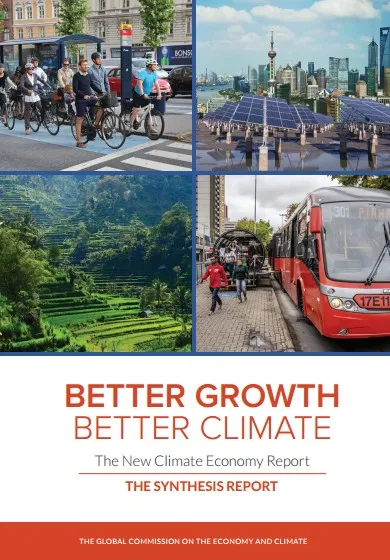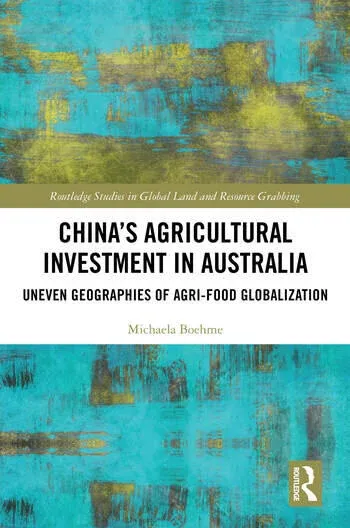A major new report released by a commission of global leaders finds that governments and businesses can improve economic growth and reduce their carbon emissions together. Rapid technological innovation and new investment in infrastructure are making it possible today to tackle climate change at the same time as improving economic performance.

The Global Commission on the Economy and Climate comprises 24 leaders from government, business, finance and economics in 19 countries. A year-long study has been conducted by leading research institutes from Brazil, China, Ethiopia, India, South Korea, the United Kingdom and United States, advised by a panel of world-leading economists chaired by the UK’s Lord Nicholas Stern.
The report’s conclusion is that countries at all levels of income now have the opportunity to build lasting economic growth at the same time as reducing the immense risks of climate change.
The next 15 years will be critical, as the global economy undergoes a deep structural transformation. It will not be “business as usual”. The global economy will grow by more than half, a billion more people will come to live in cities, and rapid technological advance will continue to change businesses and lives. Around US$90 trillion is likely to be invested in infrastructure in the world’s urban, land use and energy systems. How these changes are managed will shape future patterns of growth, productivity and living standards. The next 15 years of investment will also determine the future of the world’s climate system.
It argues that future economic growth does not have to copy the high-carbon, unevenly distributed model of the past. There is now huge potential to invest in greater efficiency, structural transformation and technological change in three key systems of the economy:
- Cities: These generate around 80% of global economic output, and around 70% of global energy use and energy-related GHG emissions. Cities: Building better connected, more compact cities based on mass public transport can save over US $3 trillion in investment costs over the next 15 years. These measures will improve economic performance and quality of life with lower emissions.
- Land: Land use productivity will determine whether the world can feed a population projected to grow to over eight billion by 2030, while sustaining natural environments. Food production can be increased, forests protected and land use emissions cut by raising crop and livestock productivity, using new technologies and comprehensive approaches to soil and water management. Restoring just 12% of the world’s degraded agricultural land could feed 200 million people by 2030, while also strengthening climate resilience and reducing emissions. Slowing down and ultimately halting deforestation can be achieved if strong international support is combined with strong domestic commitment to forest protection and rural income development.
- Energy: As the price of solar and wind power falls dramatically, over half of new electricity generation over the next 15 years is likely to be from renewable energy, reducing dependence on coal. . In developing countries, decentralised renewables can help provide electricity for the more than one billion people without access. Greater investment in energy efficiency – in businesses, buildings and transport – has huge potential to cut and manage demand
Across all these systems, three “drivers of change” need to be harnessed to overcome market, policy and institutional barriers to low-carbon growth:
- Resource efficiency: Phasing out the $600 billion currently spent on subsidies for fossil fuels (compared to $100 billion on renewable energy) will help to improve energy efficiency and make funds available for poverty reduction. A strong and predictable price on carbon will drive higher energy productivity and provide new fiscal revenues, which can be used to cut other taxes. Well-designed regulations, such as higher performance standards for appliances and vehicles, are also needed.
- Infrastructure investment: New financial instruments including green bonds, risk-sharing instruments and products which align the risk profile of low-carbon assets with the needs of investors, can cut capital costs for clean energy by up to 20%.
- Innovation: Advances in digitisation, new materials, life sciences and production processes have the potential to transform markets and dramatically cut resource consumption. But technology will not automatically advance in a low-carbon direction. It requires clear policy signals, including the reduction of market and regulatory barriers to new technologies and business models, and well-targeted public expenditure. To help create the next wave of resource-efficient, low-carbon technologies, public research and development (R&D) investment in the energy sector should triple to well over US$100 billion a year by the mid-2020s.
The report proposes a 10-point Global Action Plan of key recommendations. This asks decision-makers to:
- Accelerate low-carbon transformation by integrating climate into core economic decision-making processes. This is needed at all levels of government and business, through systematic changes to policy and project assessment tools, performance indicators, risk models and reporting requirements.
- Enter into a strong, lasting and equitable international climate agreement, to increase the confidence needed for domestic policy reform, provide the support needed by developing countries, and send a strong market signal to investors.
- Phase out subsidies for fossil fuels and agricultural inputs, and incentives for urban sprawl, to drive more efficient use of resources and release public funds for other uses, including programmes to benefit those on low incomes.
- Introduce strong, predictable carbon prices as part of good fiscal reform and good business practice, sending strong signals across the economy.
- Substantially reduce capital costs for low-carbon infrastructure investments, expanding access to institutional capital and lowering its costs for low-carbon assets.
- Scale up innovation in key low-carbon and climate-resilient technologies, tripling public investment in clean energy R&D and removing barriers to entrepreneurship and creativity.
- Make connected and compact cities the preferred form of urban development, by encouraging better-managed urban growth and prioritising investments in efficient and safe mass transit systems.
- Stop deforestation of natural forests by 2030, by strengthening the incentives for long-term investment and forest protection, and increasing international funding to around US$5 billion per year, progressively linked to performance.
- Restore at least 500 million hectares of lost or degraded forests and agricultural lands by 2030, strengthening rural incomes and food security.
- Accelerate the shift away from polluting coal-fired power generation, phasing out new unabated coal plants in developed economies immediately.
The report says that implementing the policies and investments proposed in this report could deliver at least half of the reductions in emissions needed by 2030 to lower the risk of dangerous climate change.
The land use and agriculture section of the report in more detail:
The report provides an analysis of the challenges (GHG emissions, land and forest degradation, deforestation, impacts of climate change on food production etc) and then considers changes both on the supply and the demand side.
As regards supply, the report urges more investment in agricultural research and development (a doubling from its current US$15 billion US$30 billion by 2030). It also says that there should be a reduction in unsustainable input subsidies, with funds instead being redirected to support for social goods (protection of ecosystem services) and direct payments to farmers. The Commission recommends that government and their development partners commit to restoring 150 million ha of degraded agricultural land through scaled-up investment and adoption of landscape-level approaches. There should also be a sharp increase in funding for climate change adaptation.
The report also considers demand side actions although the text is somewhat contradictory. In the ‘supply side’ section it cites this much quoted figure in terms that make it appear inevitable: “By 2050, the world’s farms will need to produce 70% more calories than in 2006, mainly due to population growth, rising incomes and changing diets in developing countries.35 Meeting this new demand will be critical to growth, food security and poverty alleviation; it will also create huge opportunities for businesses – from small farms and local businesses, to multinationals. How this demand is met will be critical to climate outcomes.”
And yet in the demand side section it highlights the need to address food waste and shift diets away from resource intensive patterns: “To ease pressure on the land, demand-side measures are also important. On a caloric basis, a quarter of world’s food is now wasted between farm and fork. For example, food waste reduction measures in developed countries could save US$200 billion per year by 2030, and reduce emissions by at least 0.3 Gt of CO2e.59 Policy-makers should also work to reduce demand for food crops for biofuels and promote a shift in diets, away from red meat especially.
As regards recommendations for this section, it states that nations and companies should commit to reducing the rate of post-harvest food loss and waste by 50% by 2030 relative to present levels. Governments that subsidise or mandate the use of biofuels should phase out these interventions to the extent that they involve food crops. There are no diet-related recommendations.
The report estimates that following the above recommendations in agriculture, forests and land use change would very conservatively yield an abatement range of between 4.2 to 10.4 Gt CO2e per year in 2030, with an expectation of 7.3 Gt CO2e. The main sub-components of this estimate are: boosting agricultural productivity through a focus on “climate-smart agriculture” innovation (0.6–1.1 Gt); improved forest governance and conservation measures to achieve zero net deforestation, supported by REDD+ (1.6–4.4 Gt); restoring 150 million ha of degraded agricultural land and 350 million ha of degraded forest landscapes, for a total of 500 million ha (1.8–4.5 Gt); and reduced food waste (0.2– 0.4 Gt).
Citation
Better Growth, Better Climate, 2014, Global Commission on the Economy and Climate
You can download the report at www.newclimateeconomy.report. See more information from the Global Commission on the Economy and Climate here.
The report has received substantial media coverage. See for example an article from BBC here, from Greenbiz here and Green alliance here. New York Times also provides coverage here.




Comments (0)